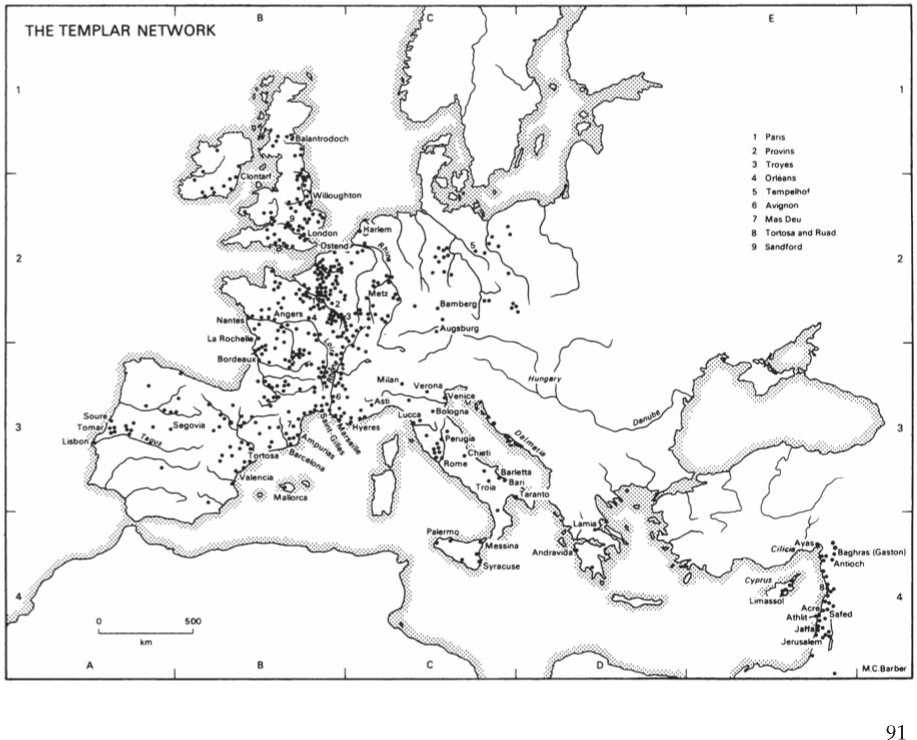The Templars were founded in 1119 with the limited aim of protecting the pilgrim routes between Jaffa and Jerusalem and the adjacent holy sites. At first they attracted little attention, but papal confirmation granted at the Council of Troyes in 1128, followed by a vigorous recruiting drive in the West, set in motion an expansion which, during the twelfth century, transformed them from a small charitable association into an international corporation,
Possessing estates in all the Christian lands. According to the Rule of the Order their possessions were divided into ten provinces, each governed by a hierarchy of commanders ultimately responsible to the Grand Master. By this means new members were recruited and a set proportion of income sent to the East in the form of responsions. The need to make large sums of money available in the various different parts of Christendom soon led to the

Development of a complementary banking structure. This vast organization was geared to the protection of the crusader lands in the East where, at various times the Order was responsible for at least fifty-three fortified places, ranging from massive castles like Athlit and Safed to small watch-towers in which pilgrims could take refuge. By the 1180s it could muster over 600 knights and 2000 sergeants in Outremer.
This network was therefore a complex backup organization for the front-line. Since these possessions originally derived from the generosity of pious benefactors, there was inevitably a certain random element in the pattern, but the map shows the effects of shrewd management unrestricted by the desire for isolation that affected the distribution of Cistercian houses. The Order had houses in the major Atlantic and Mediterranean ports, while its inland possessions cluster around the main trade and pilgrim routes to and from northern Europe: in the east through Champagne, along the Rhone and into Provence and Italy, and in the west through Normandy, Anjou and the Charente into Languedoc and Iberia. Indeed, the expansion of the reconquest in Spain created a second front for the Order, where it became well-established in Aragon and, later, Portugal, although the Castilian rulers relied much more upon local military orders. The Templars were least important along Christendom's eastern frontier, dominated first by the Hospital and, from the early thirteenth century, by the Teutonic Knights. Nevertheless, one of the provinces listed by the Rule was that of Hungary which in this period incorporated Dalmatia, a region in which it seems likely that the Templars held many more houses than can at the moment be shown with any certainty on a map. The Order's shipping maintained regular links with Outremer, where the Templars had their own quays and warehouses in all the main ports of the Palestinian and Syrian mainland and, in the thirteenth century, in Cyprus and Cilicia as well. In 1307 the Templars were arrested in France, accused of heretical and immoral activity by the government of Philip IV, and during the next two years they were similarly seized in other countries as well. Although there was little substance in the charges the Order was suppressed by the papacy in 1312 and its lands transferred to the Hospitallers.
At its height the membership is unlikely to have been fewer than 5,000, excluding dependants of various kinds, nor to have had fewer than 800 houses, ranging from great complexes like the Paris Temple to remote rural preceptories administered by perhaps two brothers. A map of this kind should therefore be used with caution, for it cannot mark every single establishment, nor show their relative importance. Moreover, the situation was never static; a more dynamic picture would require several maps.
M. C.Barber




 World History
World History









